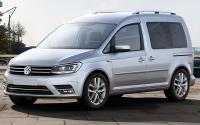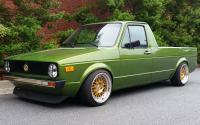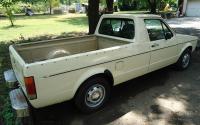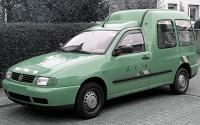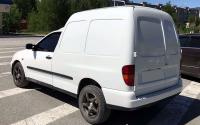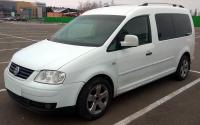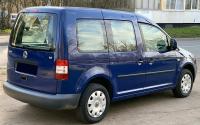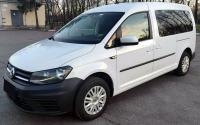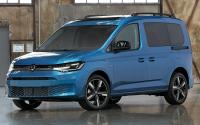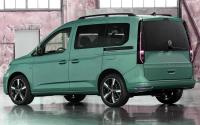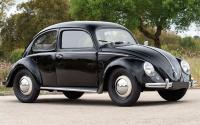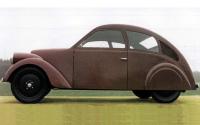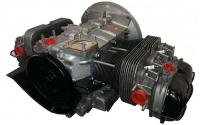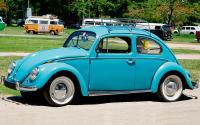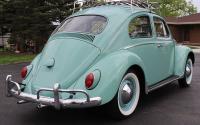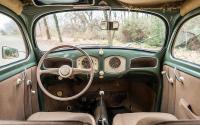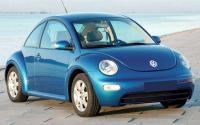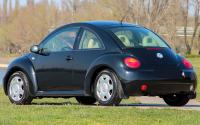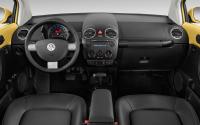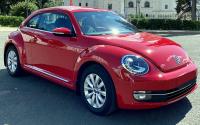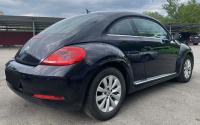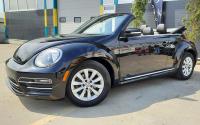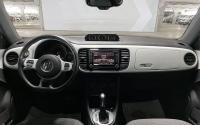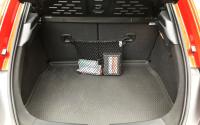Volkswagen Caddy
Volkswagen Cuddy – currently a German minivan for commercial use (M-segment), produced by Volkswagen from 1979 to the present. Introduced to world markets in 1980, appeared in Europe in 1982. The first and second generations also had a body «pickup». The fourth generation is currently being produced.
Some of its current competitors are Citroen Berlingo, Fiat Doblo, Ford Connect, Hyundai H-1, LADA Largus, Mercedes Citan, Nissan NV200, Peugeot Partner, Renault Kangoo, Suzuki APV and Opel Combo.
First generation (Typ 14, 1979-1995)
First generation «VW Caddy 1» with body «pickup» was developed for the North American market, first introduced to the public in 1978, and began production in 1979. The pickup truck was based on the platform «A1», which also produced «VW Golf» first generation and had a name «VW Rabbit Pickup». Body length was 4370 mm, width 1640 mm, height 1430 mm, wheelbase 2625 mm and ground clearance 149 mm. Trim levels were available such as «LX» and «Sportruck». Production and assembly was carried out in the USA, Yugoslavia and South Africa. While «Rabbit Pickup» competed with compact pickups such as Ford Courier, Datsun Truck, Toyota Hilux and Subaru BRAT.
The range of petrol engines includes three models, all 1.5-liter in-line four-cylinders (1457 cm3, 70 hp), 1.6 liters (1595 cm3, 75 hp) and 1.8 liters (1781 cm3, 95 hp). Diesel engines were two models with a volume of 1.5 liters (1471 cm3, 48 hp) and 1.6 liters (1588 cm3, 54 hp). The transmission was only a mechanical 4-speed. During the long production in South Africa, the engines were modernized - the power increased slightly.
Second generation (Typ 9K, 1995-2004)
Second generation with code «Typ 9K» began production in 1995, production was in Spain until 2004 and in Argentina until 2008. The car is based on a platform «A03», which was also used for «VW Polo» third generation, «SEAT Inca», «SEAT Cordoba» and «SEAT Ibiza» second generation. In 1996, a modification appeared «Typ 9U», which was produced in the Czech Republic and was essentially a model «Skoda Felicia Pickup». The body was of two types - a windowless van and a compact passenger minivan with a length of 4207 mm, a width of 1695 mm, a height of 1846 mm, with a wheelbase of 2600 mm, a ground clearance of 176 mm and a curb weight of 1115 kg.
Petrol engines were four-cylinder fuel injected with the following specifications: 1.4 liters (1390 cm3, AEX/APQ, SOHC, MPI, 60 hp), 1.4 liters (1390 cm3, AUA, DOHC, MPI, 75 hp), 1.6 liters (1595 cm3, 1F, SOHC, SPI, 75 hp) and 1.6 liters (1598 cm3, AEE, SOHC, MPI, 75 hp). Diesel engines are also all with direct fuel injection of the following volumes: 1.7 liters (1716 cm3, AHB, SDI, 57 hp), 1.9 liters (1896 cm3, 1Y, 64 hp), 1.9 liters (1896 cm3, AEY/AYQ, SDI, 64 hp) and 1.9 liters (1896 cm3, 1Z/AHU/ALE/ALH, TDI, turbo, 90 hp). The transmission was only a five-speed manual.
Third generation (Typ 2K, 2003-2020)
The third generation began production in autumn 2003 with the code «Typ 2K» and was produced until 2020 in Algeria, China, Poland and Russia. The minivan is based on the platform «A5», which is also used for «VW Golf» fifth generation And «VW Touran» first generation, but «Caddi» rear rigid axle with leaf springs instead of independent suspension. Two body shapes - van and minivan (Life). Each body exists with an extended wheelbase with an addition to the name «Maxi». The car has the following dimensions: length 4405 mm (4875 mm Maxi), width 1794 mm, height 1834 mm, wheelbase 2682 mm (3002mm Maxi), ground clearance 179 mm and curb weight 1325-1551 kg. This generation ceased to be a pickup truck, it was replaced by «VW Amarok».
Gasoline engines were installed all four-cylinder in-line with fuel injection of 1.2 liters (1197 cm3, CBZA/CBZB, turbo, 85/110 hp), 1.4 liters (1390 cm3, BCA/BUD, 75/80 hp) and 1.6 liters (1598 cm3, BGU/BSE/BSF, 102 hp). Diesel engines were also four-cylinder, all 1.6-liter turbocharged (1598 cm3, CAYE/CAYD, 75/102 hp), 1.9 liters (1896 cm3, BSU/BJB/BLS/BLS, 75/105 hp) and 2.0 liters (1968 cm3, BDJ/BST/BMM/CFHE/CLCA/CFHF/CFHC/CFJA, 96-170 hp). Also from the factory were cars with engines running on liquefied (LPG) or compressed (CNG) natural gas 1.6 liters (1598 cm3, BFX/BFW, LPG, 98 hp) and 2.0 liters (1984 cm3, BSX, CNG, 109 hp). Almost all models were equipped with a mechanical 5-speed transmission, and some diesel models had a 6-speed robot.
In the summer of 2010, they carried out a small update of the appearance. In 2015, a deeper restyling was carried out, which also included the conversion of engines to Euro 6 standards. This update received the code «Typ 2K SA» and is represented by Volkswagen as fourth generation (Mk4).
Fifth generation (2020-present)
«VW Caddy 5» unveiled in February 2020 and was scheduled to have a public presentation at the Geneva International Motor Show in March 2020, but it was canceled due to the coronavirus outbreak. The car went on sale in January 2021. The car is based on a modular platform «MQB evo», which is also used for other vehicles of the concern «Volkswagen Group»: «Audi A3 8Y», «Seat Leon IV», «Skoda Octavia IV» and «VW Golf VIII». This fifth generation is indeed new, compared to the fourth, which is just a facelift. Here, the rear suspension on leaf springs has been replaced with an axle with a torsion beam.
The car is equipped with the latest electronic driver assistance systems. There are still two bodies - a commercial van and a passenger minivan, both in two versions with a prefix «Maxi». Body dimensions are as follows: length 4601 mm (4954 mm Maxi), width 1855 mm, height 1819 mm, wheelbase 2755 mm (2970 mm Maxi), clearance 144-169 mm and curb weight 1515-1684 kg.
From the beginning of production, the car is available with a 1.5-liter gasoline engine (1498 cm3, TSI, 114 hp), 1.5 liter natural gas engine (1498 cm3, TGI, 130 hp) and 2.0 liter diesel engines (1968 cm3, TDI, 75-122 hp). Almost all models were equipped with a six-speed manual transmission, and a seven-speed robotic automatic was also installed.
Volkswagen Beetle
Volkswagen Beetle — (English - beetle, bug; German - kafer) a subcompact two-door economy car produced by the German automaker Volkswagen from 1938 to 2003. It is the first rear-engined car and is also one of the most produced cars in the world, with over 21 million units produced and sold. It was developed by Ferdinand Porsche in 1931 in terms of the concept «people's car», but mass production began only by the end of the 1940s.
The body is made in the form of a shell, and the interior is designed for four people. Body length was 4030-4080 mm, width 1540-1585 mm, height 1500-1550 mm, wheelbase 2400 mm, curb weight 695-890 kg. Suspension front and rear - independent with torsion bars and springs. In the steering of cars of the first years of production, a worm gear was used. It was later replaced with a more advanced ball screw. In the 1960s, a damper was added to reduce vibration on the steering wheel, and the steering column began to fold in a frontal collision. The braking system at the beginning was cable, from the 1950s hydraulic brakes began to be installed, and in the 1960s disc brakes appeared at the front.
At first, the car was with an air-cooled four-cylinder boxer engine. The first engine was a 1.0 liter (995 cm3, OHV, 25 HP, 1938-1942). Then came the 1.1 liter engines (1131 cm3, 30 hp, 1945-1953), 1.2 liters (1192 cm3, 36-40 hp, 1954-1966), 1.3 liters (1285 cm3, 50 hp, 1966-1967), 1.5 liters (1493 cm3, 44 hp, 1967-1970), 1.6 liters (1584 cm3, 41 hp, 1971-1979). Until 1975, all engines were carbureted, and then they began to install an electronic fuel injection system.
The transmission was a mechanical four-speed, but since 1961 it was possible to install «Saxomat» - a semi-automatic transmission with which it was not necessary to survive the clutch, but the gears were switched manually.
As technology has evolved, the Volkswagen Beetle has been upgraded throughout its years of production. The 1950s saw a major redesign with hydraulic brakes, a single split rear window, a new instrument panel, a larger engine, and exterior design changes, including twin chromed exhaust pipes.
Many improvements also appeared in the 1960s - a front anti-roll bar, a hydraulic steering damper, increased engine power for the same volume, flashing direction indicators appeared instead «semaphores», the rear suspension has been significantly redesigned, as well as smaller improvements and exterior design changes. In 1967, a 1.5 liter engine appeared and the entire electrical system was transferred from 6 volts to 12 volts.
In 1968, the headlights and taillights were greatly changed. A number of safety improvements were made - these included external triggered door handles, a secondary front hood latch, a folding steering column, padded vent window latches, a pivoting glove box latch, and labeled instrument panel handles. A new semi-automatic three-speed transmission with a torque converter and a vacuum clutch appeared, and the cars were sold under the name «VW Automatic».
In the 1970s, a model of increased comfort appeared «Luxus», by adding a letter to the name «L». In addition to the regular-sized Beetle, an enlarged version appeared, in which the trunk volume increased by 40%. The engine was increased to a volume of 1.6 liters. A new front suspension with MacPherson struts was used, the front track was slightly expanded. From 1975, some models were equipped with Bosch L-Jetronic fuel injection and a catalytic converter.
The production of the car was at first only in Germany. Since 1953, they began to be assembled in Brazil from the supplied parts, and in 1959 a full-fledged production was opened. In 1955, the assembly was established in Mexico, and full-cycle production began in 1964. Some countries such as Australia, Ireland, Indonesia, Nigeria, Thailand, South Africa and Yugoslavia assembled the car using the CKD method (CKD) under license from Volkswagen.
Volkswagen New Beetle (1997-2011)
In 1997, Volkswagen introduced a compact car with the exterior design of the classic Beetle, but technically it's a completely different car - the engine is in the front with front-wheel drive, the trunk is in the rear like most modern cars. Production lasted until 2011. Platform based «VW Group A4 (PQ34)», which is also used for cars Audi A3, VW Golf, VW Bora/Jetta, VW Lavida, SEAT Leon, SEAT Toledo, Skoda Octavia. The dimensions of the body did not differ much from the classics and was 4129 mm long, 1721 mm wide, 1511 mm high and had a wheelbase of 2515 mm. The curb weight was 1230 kg.
The concept of this car was presented in 1994 at the North American International Auto Show under the name «Concept One», and a convertible version was also shown at this year's Geneva Motor Show. In 1995, it was also shown at the Tokyo Motor Show. The strong positive response from showroom visitors led the company to decide to produce a production model.
In 2006, the car was restyled - the appearance was slightly redesigned, the bumpers and wheel arches became more angular, and the engines were also updated.
The range of gasoline engines consisted of the following 1.4-liter models (1390 cm3, I4, 75 hp), 1.6 liters (1595 cm3, I4, 101 hp), 1.8 liters (1781 cm3, I4, turbo, 150/180 hp), 2.0 liters (1984 cm3, I4, 116 hp), 2.3 liters (2324 cm3, VR5, 170 hp), 2.5 liters (2480 cm3, I5, 150 hp) and 3.2 liters (3189 cm3, VR6, 225 hp). The diesel engine was the same volume of 1.9 liters (1896 cm3, 90/101/105 hp), four-cylinder, in-line, turbocharged. Transmission was offered 5, 6-speed manual, 4, 6-speed automatic.
Volkswagen Beetle A5 (2011-2019)
This is the second generation reincarnation of the original Volkswagen Beetle and is a small family car produced from 2011 to 2019. Platform based «Group A5 (PQ35)», which is also used for other cars of the concern - Audi A3, Audi Q3, Audi TT, SEAT Altea, SEAT Leon, SEAT Toledo, Skoda Octavia, Skoda Yeti, Volkswagen Touran / Caddy / Golf / Jetta / Scirocco / Eos of the same model years. The dimensions of the body were slightly increased compared to the previous one and amounted to - length 4278 mm, width 1808 mm, height 1486 mm, wheelbase 2537 mm and curb weight 1307 kg.
The car was first shown simultaneously at the 14th Shanghai Auto Show and at the New York International Auto Show in April 2011. It was announced at the 2018 Geneva Motor Show that this is the latest generation of the Beetle.
Four-cylinder gasoline engines were turbocharged with the following characteristics and volumes - 1.2 liters (1197 cm3, EA111, 105 hp), 1.4 liters (1395 cm3, EA211, 150/160 hp), 1.8 liters (1798 cm3, EA888, 170 hp) and 2.0 liters (1984 cm3, EA888, 200/210/220 hp), five-cylinder gasoline engine was 2.5 liters (2480 cm3, 170 hp) and without turbocharging. Diesels were all four-cylinder turbocharged 1.6-liter (1598 cm3, EA189, 105 hp) and 1.9 liters (1968 cm3, EA189/EA288, 110/140/150 hp). The transmission was a six-speed manual or DSG robot.

